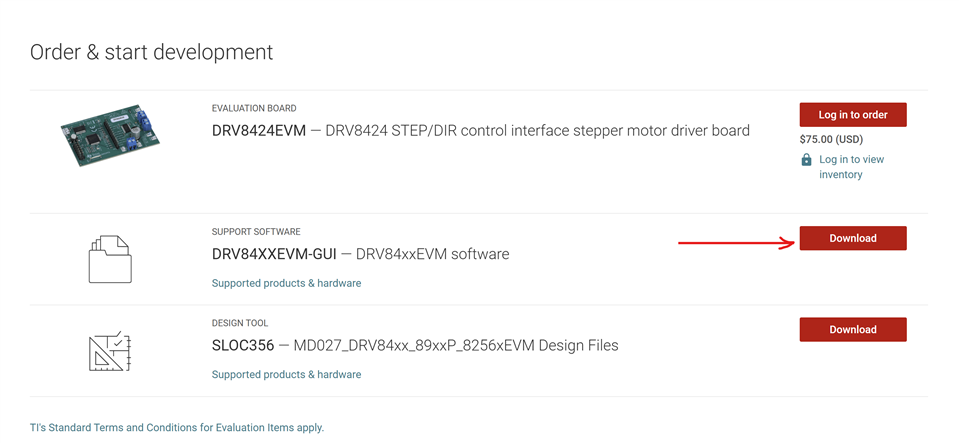Tool/software:
Could ti team help to provide DRV8424RGER driver code for our test
This thread has been locked.
If you have a related question, please click the "Ask a related question" button in the top right corner. The newly created question will be automatically linked to this question.
Hi Du,
Thanks for your question.
We provide the complete C source code and TI CCS project files for the DRV8424EVM. We do not have a separate driver code. The firmware can be downloaded from the EVM webpage. See below screenshot.
The DRV8424 is GPIO controlled. Other than setting up modes one time such as awake, driver enable, microstepping, decay mode, TOFF and VREF voltage input, only two control pins are required to control the motor. STEP input pulses usually a 50 % duty cycle PWM whose frequency will determine speed of the motor and DIR input logic level 0 or 1 for CW or CCW rotation direction. Thank you.

Regards, Murugavel
Hi Murugavel
Thanks for your reply.
We'd like to connect DRV8424 to MCU(nordic). Since I have no more experience for the motor development, Could you help to provide more details about how to develop it. About this motor, I don't need to set register and only need to control two gpios for STEP and DIR, right?
Hi Du,
About this motor, I don't need to set register and only need to control two gpios for STEP and DIR, right?
You're correct. The device uses simple GPIO port control. For STEP input typically a square wave (50 % PWM) at the desired frequency should be input. DIR is a logic 0 or 1 for CW and CCW. You will have to provide the desired VREF input voltage based on the stepper current you want to set as well as set device to awake with nSLEEP pin to 1, ENABLE must be 1 for outputs to be enabled, microstep mode with M0 and M1 pins - see datasheet Table 7-3. Microstepping Indexer Settings, decay mode with DECAY0 and DECAY1 pins, and TOFF. For decay you can use Smart Tune Ripple Control DECAY0 = 0 and DECAY1 = 1. TOFF = 1. You can have fixed settings for M0, M1, DECAY0, 1, TOFF, nSLEEP. Control ENABLE with one IO, must be 1 for motor to run and provide STEP and DIR inputs.
If you happen to have our EVM you can isolate the on-board MCU by removing 0 Ω jumper resistors and connecting external MCU IO to the header. See below.

Regards, Murugavel